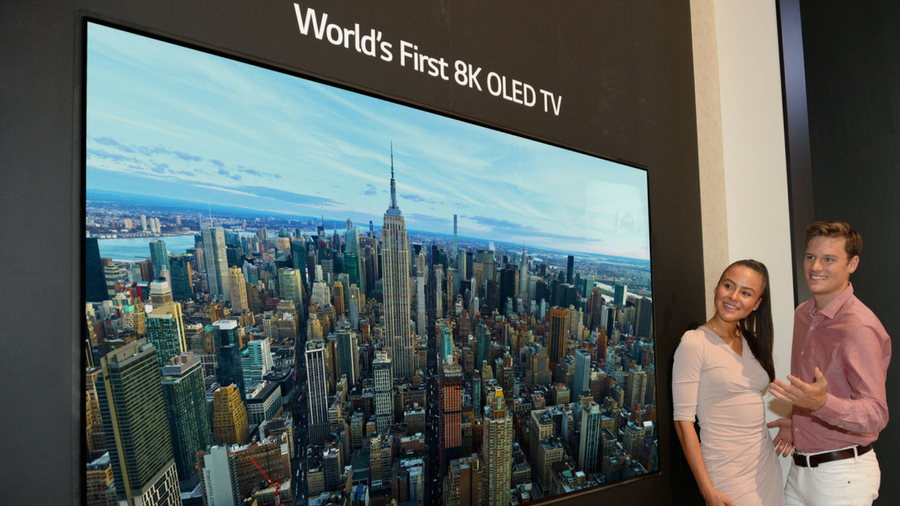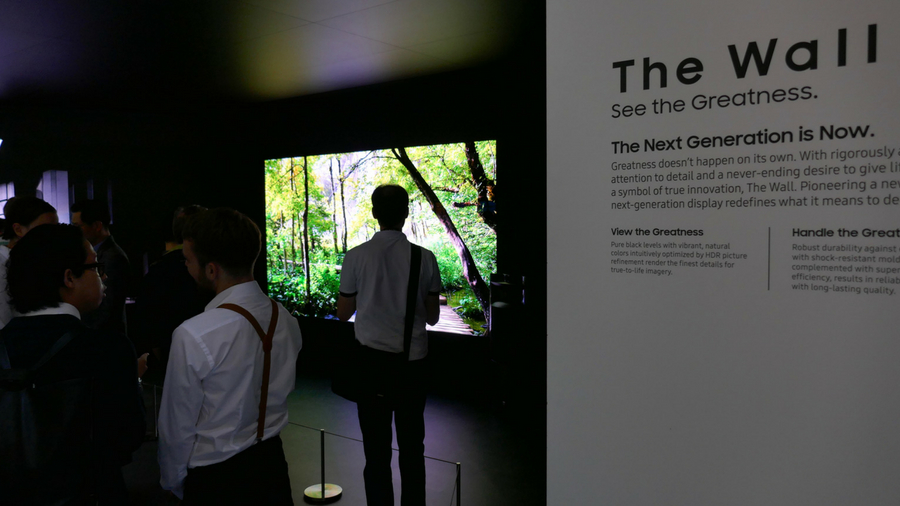The best 8K TVs spotted at IFA 2018

8K is here. It’s been talked about for years, but commercially available 8K TVs finally arrived in force at IFA 2018 in Berlin.
While the 8K TV market is still in its pre-infancy, it’s expected to hit 5 million sales by 2022. By that time the 33MP TV tech will be mature, though many in Berlin were asking one key question: what’s the point if there’s nothing to watch?
“8K broadcast by satellite starts in Japan in December, no other country has any plans in the pipeline for 8K,” says Paul Gray, a Research and Analysis Director within IHS Technology.
“We reasonably need another codec generation beyond HEVC, and even then, the business case has to be justified.”
Meanwhile, here are all the 8K TVs launched at IFA 2018...
Samsung Q900R QLED

Samsung has done some 8K tests with broadcasters in Korea, and at IFA 2018 it launched no less than four 8K QLED TVs. If that was a surprise to most, it does at least show that Samsung understands 8K very well, because the biggest was 88-inches in size.
That’s beginning to get to the size where 8K resolution actually brings a visual advantage, though it also has 65, 75, 82 and 85-inch 8K TVs.
Sign up for breaking news, reviews, opinion, top tech deals, and more.
All of them have so-called 8K AI Upscaling, but let’s be honest here: Samsung is talking about advanced algorithms that indulge in object recognition. Is that artificial intelligence? It’s definitely stretching the definition, though the ability to upscale from 4K to 8K is going to be a massive topic in 8K TVs.
Talking of which, the Q900R TVs also have Real 8K Resolution, Q HDR 8K and a Quantum Processor 8K.
Crucially, the Q900R reach the HDR-capable 4,000 nits of peak brightness, which is not something that LG’s 8K OLED can muster.
- Hands on: Samsung Q900R 8K QLED TV review
TCL FIBA Basketball World Cup 2019 Edition 8K QLED TV

It’s a bit of a mouthful, but this commercial tie-in with the International Basketball Federation (FIBA) sees Chinese brand TCL involved in 8K for the first time. It also used IFA 2018 to announce its arrival in the UK market.
Its 20mm-slim 8K set uses a quantum dot display with 1,000 nits peak brightness and 832-zone local dimming for HDR and Dolby Vision HDR. It’s also got an Onkyo sounder with Dolby Atmos embedded in the base, which can work when the TV is switched-off, even via voice control. Nice idea.
You can expect more 8K TVs from TCL; in May its panel subsidiary CSOT added a second production line that will be dedicated to producing 65-inch, 70-inch and 75-inch 8K displays.
- First Look: TCL 8K QLED TV
Sharps AX1 LED

Sharp is the only brand around that was able to use IFA 2018 to preview its second-generation 8K TVs.
Having launched an 8K TV in April, the £10,000+ LC-70X500E, Sharp debuted in Berlin its new AX1 Series of 8K TVs for launch in December (Asia) and early 2019 (rest of the world). The 60-inch 8T-C70AX1 , 70-inch 8T-C70AX1 and 80-inch 8T-C70AX1 all boast HDR, HLG, 8K up-conversion, and USB 8K pictures slide show mode.
“Sharp has an advantage in that its domestic Japanese market is already gearing up for 8K broadcasts, what the Japanese call Super Hi-Vision,” says James Edwards, an analyst at Futuresource.
“Sharp is seeking to take advantage of Foxconn’s ownership stake in Innolux to be a first mover in the market and so released its 8K monitor in Europe.”
Toshiba’s 65-inch ‘concept’ 8K LED

Vestel, the licensee of Toshiba for TVs in Europe, used IFA 2018 to show-off a 65-inch 8K TV concept compete with HDR and an 8K upscaler.
“An important advance for the future of storytelling, 8K is set to re-define our TV viewing experience,” said Bart Kuijten, European Sales and Marketing Director at Vestel. “Making TV more interactive and immersive than ever before, it opens the door to new and exciting possibilities, even offering the kind of high resolution required for viewers to one day be able to zoom into the on-screen action.”
That’s a very good point; sports broadcaster will no longer have to move their cameras during a football match, but merely record using a wide-angle lens, and digitally zoom-in for a 4K close-up. Kuijten also revealed that Toshiba is working on an 8K TV for mainstream viewing.
LG’s 88-inch 8K OLED prototype

At IFA 2018, LG showed the same 88-inch 8K OLED TV it had at CES 2018, along with the pronouncement that it wants to lead ‘the ultra-premium market’.
“LG’s first 8K OLED TV is the pinnacle of technological achievement and the next evolutionary step in display technology,” said Brian Kwon, president of LG Home Entertainment Company.
“4K OLED played a major role in reshaping TV industry and LG is confident that 8K OLED will do the same.”
It’s not clear whether LG’s 8K TV will go on sale soon, but it would appear to be nearing commercial availability. LG insists that OLED TV shipments – a category for which it is solely responsible (no other company makes OLED TVs) – is expected to double in 2018 and reach over nine million units by 2022.

Is it harder to create an 8K TV with OLED?
However, there are doubts that OLED technology can achieve 8K resolutions as easily as LED-based technology, which every other 8K TV-maker is using. OLED is very different to LED, with each pixel emitting its own light rather than using a backlight. “Finer pixel density is always hard for emissive displays, so it does represent some kind of breakthrough, although this will be progressively harder at smaller screen sizes,” says Gray.
"LCD has advantages at finer densities but there is a penalty in light transmission and efficiency instead.”
In short, LG’s 8K OLED could be significantly less bright than Samsung, Sharp and Toshiba’s 8K TVs, and the fact that it was behind closed doors suggests LG didn’t want any criticism.
Will we see Samsung’s The Wall in 8K soon?
Samsung’s massive 4K 146-inch micro LED TV known as 'The Wall’ dominated CES 2018. That’s a sweet spot size for 8K resolution, but producing video walls has its problems.
“8K does make sense for very large screens and video walls [but] finer pixel pitches are a serious challenge,” says Gray.
“Generally we see that LED video walls increase 5x or more in price with a halving of pixel pitch, so double the resolution for a given size.”
Since its 0.84mm pitch for 4K would need to be 0.42mm pitch for 8K, there’s a bigger problem. “If ‘The Wall’ was priced somewhere over the US$250k mark, that would make an 8K version truly incredible in pricing.”
The first million-pound TV? If they get any bigger, the 8K resolution revolution is definitely capable of that.
- IFA 2018 is Europe's biggest tech show. The TechRadar team is in Berlin to bring you all the breaking news and hands-on first impressions of new phones, watches and other tech as they're announced.

Jamie is a freelance tech, travel and space journalist based in the UK. He’s been writing regularly for Techradar since it was launched in 2008 and also writes regularly for Forbes, The Telegraph, the South China Morning Post, Sky & Telescope and the Sky At Night magazine as well as other Future titles T3, Digital Camera World, All About Space and Space.com. He also edits two of his own websites, TravGear.com and WhenIsTheNextEclipse.com that reflect his obsession with travel gear and solar eclipse travel. He is the author of A Stargazing Program For Beginners (Springer, 2015),